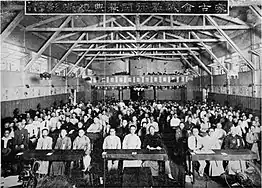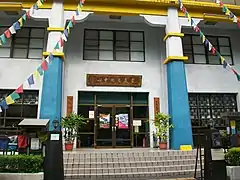Mongolian and Tibetan Affairs Commission
The Mongolian and Tibetan Affairs Commission (MTAC; Chinese: 蒙藏委員會; pinyin: Měng-Zàng Wěiyuánhuì) was a ministry-level commission of the Executive Yuan in the Republic of China (Taiwan). It was disbanded on September 15, 2017.[1][2]
| 蒙藏委員會 Měng-Zàng Wěiyuánhuì | |
 | |
| Agency overview | |
|---|---|
| Formed | April 1912 (as Mongolian and Tibetan Affairs Agency) 1 February 1929 (as MTAC) |
| Dissolved | 15 September 2017 |
| Superseding agency | |
| Jurisdiction | |
| Headquarters | Zhongzheng, Taipei |
| Parent agency | Executive Yuan |
| Website | www.mtac.gov.tw |

History

It was originally created during the Qing Dynasty in 1636 as Mongolian Bureau (Manchu: ᠮᠣᠩᡤᠣ
ᠵᡠᡵᡤᠠᠨ), later reformed into Lifan Yuan in 1639, and oversaw the relationship of the Qing court to its Mongolian and Tibetan dependencies. During Kangxi Emperor rule, the bureau was renamed to Minority Affairs Council and in 1906 renamed to Ministry of Minority Affairs (理藩部) under Guangxu Emperor rule .
Following the 1911 revolution and collapse of the Qing dynasty, the section was replaced by Mongolian and Tibetan Affairs Agency under the Ministry of the Interior in April 1912. In July 1912, the agency was again renamed as Bureau of Mongolian and Tibetan Affairs and placed under the State Affairs Yuan. In 1914, it was reorganized and being placed directly under the supervision of President. On 1 February 1929, it was finally changed to Mongolian and Tibetan Affairs Commission (MTAC) with accordance to the Nationalist Government Organizational Law.[3] After the Communist revolution in China, and the Republic of China's relocation to Taiwan, the MTAC ceased its activities in Tibet and Mongolia, although it served as a governmental body which assisted in the relationship between ethnic Mongols and Tibetans in Taiwan and increasing the communication between the Taiwanese and the Mongols as well as the Tibetans.[4]
After the 1959 Tibetan uprising, Chiang Kai-shek announced in his Letter to Tibetan Compatriots (Chinese: 告西藏同胞書; pinyin: Gào Xīzàng Tóngbāo Shū) that the ROC's policy would be to help the Tibetan people overthrow the People's Republic of China's rule in Tibet. The MTAC sent secret agents to India to disseminate pro-Kuomintang (KMT) and anti-Communist propaganda among Tibetan exiles. From 1971 to 1978, the MTAC also recruited ethnic Tibetan children from India and Nepal to study in Taiwan, with the expectation that they would work for a ROC government that returned to the mainland. In 1994, the veterans' association for the Tibetan guerrilla group Chushi Gangdruk met with the MTAC and agreed to the KMT's One China Principle. In response, the Dalai Lama's Central Tibetan Administration forbade all exiled Tibetans from contact with the MTAC.[5]
On August 14, 2017, the Executive Yuan announced that the MTAC would be dissolved by the end of the year. No budget was allocated to the MTAC for 2018. Employees and responsibilities of the commission were re-assigned to two places; the Mongolian and Tibetan Cultural Center under the Ministry of Culture, and the expanded Department of Hong Kong, Macao, Inner Mongolia, and Tibet Affairs under the Mainland Affairs Council.[6][7]
Organizational structure
- Commissioners
- Secretary's Office
- Counselor's Office
- Department of Mongolian Affairs
- Department of Tibetan Affairs
- Department of General Affairs
- Compilation and Translation
- Accounting Office
- Personnel Office
- Civil Service Ethics Office
Ministers
.jpg.webp)
Political Party: Kuomintang Democratic Progressive Party Non-partisan/ unknown
Other notable members
Mongolian and Tibetan Cultural Center

The Mongolian and Tibetan Cultural Center (Chinese: 蒙藏文化中心; pinyin: Měng-Zàng Wénhuà Zhōngxīn) was originally managed by the Mongolian and Tibetan Affairs Commission. It is located in the Daan District of Taipei on Qingtian Street near the Taipei Grand Mosque and Mandarin Training Center. The center was established in 1993 in the former residence of the Changkya Khutukhtu, Lobsang Pelden Tenpe Dronme, who fled to Taiwan after the Chinese Civil War in 1949. The building incorporates traditional Tibetan architectural features. It also includes an exhibition area for cultural artifacts, a reading room, lecture hall and prayer hall for the Changkya Khutukhtu.[8] After the commission was disbanded, the center's management was turned over to the Ministry of Culture.
See also
- Executive Yuan
- Republic of China (1912–49)
- Tibet (1912–51)
- Mongolia (1911–24)
- Mongolia–Taiwan relations
- Similar government agencies
- Bureau of Buddhist and Tibetan Affairs (Yuan dynasty)
- Lifan Yuan (Qing dynasty)
- State Ethnic Affairs Commission (People's Republic of China)
References
- "Taiwan News Quick Take - Taipei Times". www.taipeitimes.com.
- "蒙藏委員會9月15日已走入歷史 - 政治 - 自由時報電子報". 自由電子報. October 11, 2017.
- Benson, Linda (1990). The Ili Rebellion : the Moslem challenge to Chinese authority in Xinjiang, 1944-1949. Armonk, New York: M.E. Sharpe. p. 15. ISBN 978-0-87332-509-7.
- Henry George Wandesforde Woodhead & Henry Thurburn Montague Bell (1932). The China Year Book. North China Daily News & Herald. p. 28. Retrieved 2010-06-28.CS1 maint: uses authors parameter (link)
- Okawa, Kensaku (2007). "Lessons from Tibetans in Taiwan: Their history, current situation, and relationship with Taiwanese nationalism" (PDF). The Memoirs of the Institute of Oriental Culture. University of Tokyo. 152: 588–589, 596, 599, 602–603. Archived from the original (PDF) on 2012-04-24.
- "Taiwan calls time on Mongolia and Tibet affairs commission". South China Morning Post. 2017-08-16. Retrieved 2020-04-26.
- Charlier, Phillip (August 14, 2017). "Mongolian and Tibetan Affairs Commission to be Dissolved: Lim Applauds".
- "Mongolian and Tibetan Cultural Center: Introduction". Archived from the original on 2017-04-17. Retrieved 2011-01-22.
External links
| Wikimedia Commons has media related to Mongolian and Tibetan Affairs Commission. |